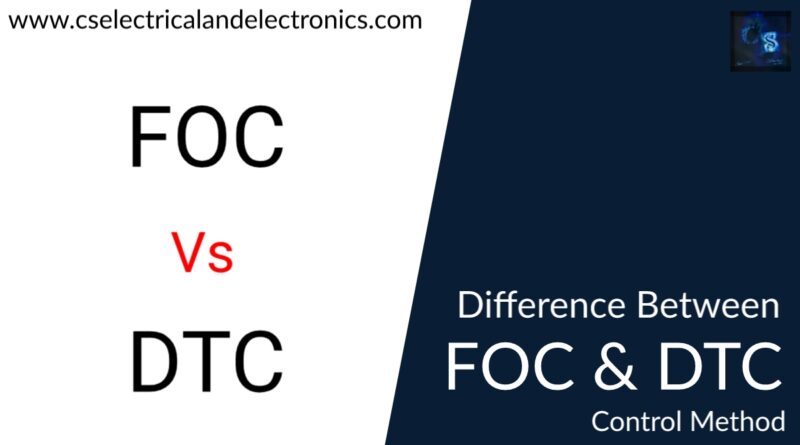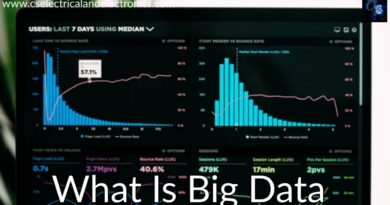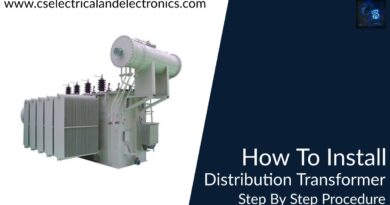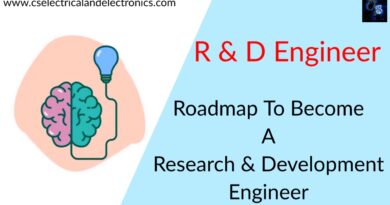Difference Between FOC AND DTC Control Methods For Motor
Hello guys, welcome back to our blog. Here in this article, we will be discussing the difference between FOC and DTC control methods for motors, what is field-oriented control method, what is direct torque control method, etc.
If you have any electrical, electronics, and computer science doubts, then ask questions. You can also catch me on Instagram – CS Electrical & Electronics.
Also, read:
- Battery Management Systems Using Artificial Intelligence
- Top 12 Latest Technologies In The Power System That Will Change Future
- How To Estimate Parameters For The Lithium-Ion Cell Model, R0, R1, C1
Difference Between FOC AND DTC Control Methods
Field-oriented Control (FOC) and Direct Torque Control (DTC) are the popular vector control methods of the drives which mainly consist of electric motors. Electrical motors played a vital role in the industrial revolution as they are present in every corner application in the world. The lifestyle without the drives and the motors are completely different but their innovation showed the major differences and impacts.
Electrical drives are specially made up of multiple motors to work with the heavy load and to give an efficient output. First of all the dc drives ruled the industrial revolution as they all work on the constant supply but there are many heavy loads that work on the AC supply and the drives are also changed the path from the dc to ac for the special operations and the easy control of the drives.
Electrical drives either ac or dc need the control center and different controlling methods using the parameters of the motor which plays the most important role in delivering the efficient output from the drives. As we all know that there are different types of speed controlling methods in the motor such as Voltage control, Field control, Current control, frequency control methods, etc. these all are used according to the output required same as the motor drives also had the different types of control methods for achieving the required output.
There are many power electronic and fact devices used for speed control and other variations in the drives. The ac drives are mainly controlled by the effective control of the electromagnetic torque and magnetic flux. Mainly the ac drives are made up of induction motors and permanent magnet synchronous motors as they give exceptional results compared to the other motors which run on ac supply.
The use of electrical drives has increased rapidly due to the heavy use of drives in all types of industries. The use of the ac drives is increased by 120 percent in the last two decades as the industrial sector is developing according to the top technologies. In the olden days, the variable speed and the variable voltage methods are used for the dc drives to control the drives and when the ac drives are introduced they needed the new controlling methods as the manufacturing of the drives increased as their applications are introduced in every corner of the world.
As the use increases and the introduction of modern technologies, there are much needed advances in the control of the drives. They mainly needed the control over the electromagnetic torque and the field of the motor as the ac drives are mainly controlled by these factors especially the induction motor and the permanent magnet synchronous motor. The Field oriented control and the Direct torque control methods control the field and the electromagnetic torque which are introduced around the 1980s at the crucial point of the industrial revolutions. Using these4 methods they obtain the dynamical performance and expected output.
Field-oriented control (FOC) has a special configuration with the linear controllers and the pulse width modulation (PWM) technique to control the load voltage of the electrical motor. This FOC is mainly used for the control of the permanent magnet synchronous motor and ac induction motors and it has the best control capability over the full torque and speed ranges.
This is the rotor field control method that controls the rotors of the electrical drives. The FOC consists of two major modes such as the field control and torque control, the implementation of the field-oriented control method needs the transformation of the stator currents from the stationary reference frame to the rotor flux reference frame of the electrical motor. Traction applications mostly use the torque control by taking the rotor torque as the reference. In the torque mode, it follows the reference torque as in the speed control method it follows the reference speed of the motor.
The FOC needs real-time feedback as the implementation of the algorithm of the field-oriented control needs real-time feedback on the currents and the rotor position as it can change the algorithm according to the output required. The sensors are used for the feedback of the currents and the rotor position to let know the FOC and make changes in the electrical parameters and the algorithm. The sensor-based feedback gives the exact values to the FOC algorithm and it uses mathematical methods to control over the drives.
Coming to the direct torque control method uses the variable frequencies to control the torque of the ac motors and it is mostly used torque control method in the industrial areas as it gives the required output. The direct torque control uses only the linear converters to control the electrical drives and it will not use any modulators like the field-oriented control which makes it the economical method of control of the drives.
Direct torque control mainly uses two-loop methods to control the drives such as the speed control and the torque control loops which will work together with the motor model. The DTC will assume the torque values and it will compare to the values of the drives then the operation of the DTC will be started after comparison. The comparator output will decide the output of the DTC. The DTC is one of the easiest and most economical controls of the drives.
When both methods are compared to each other the DTC allows the tight control of the motor speed and the torque and the direct torque control is the sensorless control it requires only the parameters for comparison when compared to the FOC and another important factor to be considered is that the direct torque control did not need any type of the modulators in the control method by this the processing time of the DTC is increased and the torque response is also increased. DTC has major advantages over the FOC.
This was about “Difference Between FOC AND DTC Control Methods“. I hope this article may help you all a lot. Thank you for reading.
Also, read:
- 10 Tips To Maintain Battery For Long Life, Battery Maintainance
- 10 Tips To Save Electricity Bills, Save Money By Saving Electricity
- 100 (AI) Artificial Intelligence Applications In The Automotive Industry
- 100 + Electrical Engineering Projects For Students, Engineers
- 1000+ Control System Quiz, Top MCQ On Control System
- 1000+ Electrical Machines Quiz, Top MCQs On Electrical Machines
- 1000+ MATLAB Simulink Projects For MTech, Engineering Students
- 50 Tips To Save Electricity At Home, Shop, Industry, Office
Author Profile
- Chetu
- Interest's ~ Engineering | Entrepreneurship | Politics | History | Travelling | Content Writing | Technology | Cooking
Latest entries
 All PostsApril 19, 2024What Is Vector CANoe Tool, Why It Is Used In The Automotive Industry
All PostsApril 19, 2024What Is Vector CANoe Tool, Why It Is Used In The Automotive Industry All PostsApril 13, 2024What Is TCM, Transmission Control Module, Working, Purpose,
All PostsApril 13, 2024What Is TCM, Transmission Control Module, Working, Purpose, All PostsApril 12, 2024Top 100 HiL hardware in loop Interview Questions With Answers For Engineers
All PostsApril 12, 2024Top 100 HiL hardware in loop Interview Questions With Answers For Engineers All PostsMarch 22, 2024Driver Monitoring Systems In Vehicles, Working, Driver Sleepy Alert
All PostsMarch 22, 2024Driver Monitoring Systems In Vehicles, Working, Driver Sleepy Alert








